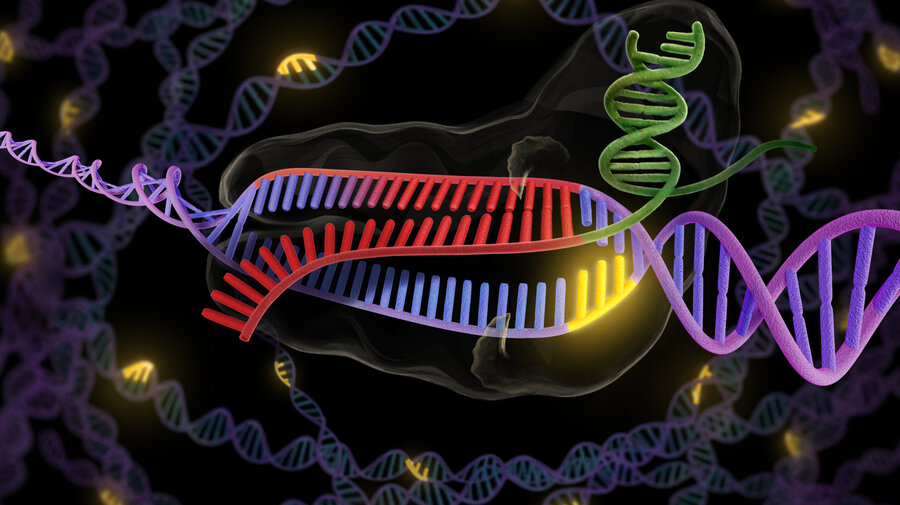Michael Specter writes a very long feature on the dangers and virtues of DNA editing, specifically the tool CRISPR, which he writes is “essentially a molecular scalpel.” Specter’s intro, which takes the case of Nantucket’s Lyme disease problem, is below, the piece in full via the New Yorker.
Early on an unusually blustery day in June, Kevin Esvelt climbed aboard a ferry at Hyannis*, bound for Nantucket Island. Esvelt, an assistant professor of biological engineering at the Massachusetts Institute of Technology, was on his way to present to local health officials a plan for ridding the island of one of its most persistent problems: Lyme disease. He had been up for much of the night working on his slides, and the fatigue showed. He had misaligned the buttons on his gray pin-striped shirt, and the rings around his deep-blue eyes made him look like a sandy-haired raccoon.
Esvelt, who is thirty-four, directs the “sculpting evolution” group at M.I.T., where he and his colleagues are attempting to design molecular tools capable of fundamentally altering the natural world. If the residents of Nantucket agree, Esvelt intends to use those tools to rewrite the DNA of white-footed mice to make them immune to the bacteria that cause Lyme and other tick-borne diseases. He and his team would breed the mice in the laboratory and then, as an initial experiment, release them on an uninhabited island. If the number of infected ticks begins to plummet, he would seek permission to repeat the process on Nantucket and on nearby Martha’s Vineyard.
More than a quarter of Nantucket’s residents have been infected with Lyme, which has become one of the most rapidly spreading diseases in the United States. The illness is often accompanied by a red bull’s-eye rash, along with fever and chills. When the disease is caught early enough, it can be cured in most cases with a single course of antibiotics. For many people, though, pain and neurological symptoms can persist for years. In communities throughout the Northeast, the fear of ticks has changed the nature of summer itself—few parents these days would permit a child to run barefoot through the grass or wander blithely into the woods.
“What if we could wave our hands and make this problem go away?” Esvelt asked the two dozen officials and members of the public who had assembled at the island’s police station for his presentation. He explained that white-footed mice are the principal reservoir of Lyme disease, which they pass, through ticks, to humans. “This is an ecological problem,” Esvelt said. “And we want to enact an ecological solution so that we break the transmission cycle that keeps ticks in the environment infected with these pathogens.”
There is currently no approved Lyme vaccine for humans, but there is one for dogs, which also works on mice. Esvelt and his team would begin by vaccinating their mice and sequencing the DNA of the most protective antibodies. They would then implant the genes required to make those antibodies into the cells of mouse eggs. Those mice would be born immune to Lyme. Ultimately, if enough of them are released to mate with wild mice, the entire population would become resistant. Just as critically, the antibodies in the mice would kill the Lyme bacterium in any ticks that bite them. Without infected ticks, there would be no infected people. “Take out the mice,” Esvelt told me, “and the entire transmission cycle collapses.”
Esvelt has spoken about Lyme dozens of times in the past year, not just on Nantucket and Martha’s Vineyard but at forums around the world, from a synthetic-biology symposium in Chile to President Obama’s White House Frontiers Conference, in Pittsburgh. At every appearance, Esvelt tells the audience that he wants his two young children—he has a three-year-old son and a daughter who is almost one—to grow up in a Lyme-free world. But that’s not really why he speaks at infectious-disease meetings, entomology conventions, and international conservation workshops. He has embarked on a mission that he thinks is far more important.
Esvelt and his colleagues were the first to describe, in 2014, how the revolutionary gene-editing tool crispr could combine with a natural phenomenon known as a gene drive to alter the genetic destiny of a species. Gene drives work by overriding the traditional rules of Mendelian inheritance. Normally, the progeny of any sexually reproductive organism receives half its genome from each parent. But since the nineteen-forties biologists have been aware that some genetic elements are “selfish”: evolution has bestowed on them a better than fifty-per-cent chance of being inherited. That peculiarity makes it possible for certain characteristics to spread with unusual speed.
Until crispr came along, biologists lacked the tools to force specific genetic changes across an entire population. But the system, which is essentially a molecular scalpel, makes it possible to alter or delete any sequence in a genome of billions of nucleotides. By placing it in an organism’s DNA, scientists can insure that the new gene will copy itself in every successive generation. A mutation that blocked the parasite responsible for malaria, for instance, could be engineered into a mosquito and passed down every time the mosquito reproduced. Each future generation would have more offspring with the trait until, at some point, the entire species would have it.
There has never been a more powerful biological tool, or one with more potential to both improve the world and endanger it. Esvelt hopes to use the technology as a lever to pry open what he sees as the often secretive and needlessly duplicative process of scientific research. “The only way to conduct an experiment that could wipe an entire species from the Earth is with complete transparency,” he told me. “For both moral and practical reasons, gene drive is most likely to succeed if all the research is done openly. And if we can do it for gene drive we can do it for the rest of science.”
